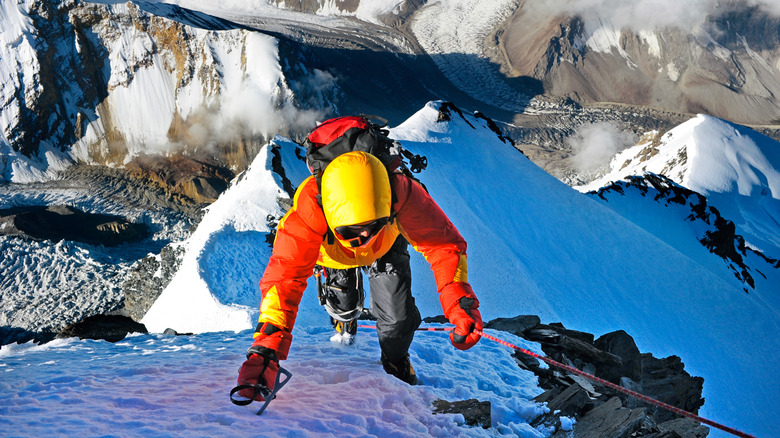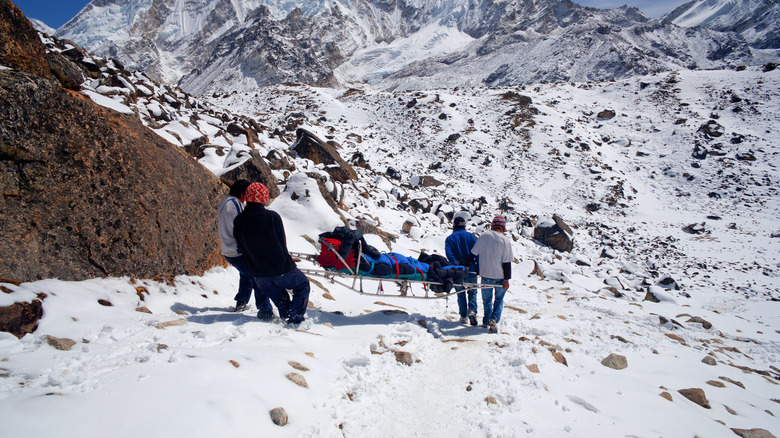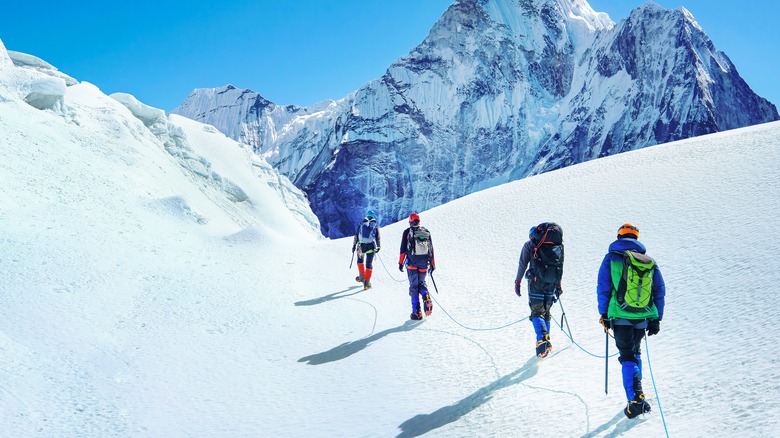A Dangerous Mountain Climbing Trend Has Been Claiming Lives On The World's Tallest Peaks
Following mountaineers on Instagram as they conquer the world's most difficult climbs is itself an adventure — and you don't even need to leave your living room. But envy and fascination quickly turn to armchair horror when accidents happen, and inevitably, they do. This was the case in the Tibetan Himalayas in October 2023.
With her trusted Sherpa guides, influencer Anna Gutu was forging her way up Shishapangma, the world's 14th-highest mountain at 26,335 feet. Soon she'd become the first American woman to scale all 14 of the world's 8,000-meter peaks, that is, unless another climber on Shishapangma who was vying for the same title, Gina Rzucidlo, beat her to the top. The race was on. Following in the wake of record-setting climbers like Nirmal Purja and Kristine Harila, Gutu and Rzucidlo had been swept up in a risky new trend: fast-climbing the world's tallest mountains.
Gutu shared her Shishapangma ascent with the world in a string of Instagram posts, her smile sparkling like sunshine, framed by rainbows of waving prayer flags. The energy crackles in these posts, and her determination is palpable. One reel, set to the song "My Addiction" by Alex Guesta, features a lean, grinning sherpa gyrating in the snow amidst bright yellow tents. The post's caption reads, "The bad news is time flies. The good news is you are the pilot. Follow your dreams. Make it count."
Tragedy on Shishapangma
But mountains don't care about your smile or how many Instagram followers you have. If you don't obey their rules — and sometimes, even if you do — they take you. On October 7, Gutu's posts came to an abrupt halt, after an avalanche near the top of Shishapangma carried her and one of her Sherpa guides to their untimely deaths. Shockingly, a little while later, a separate avalanche killed Rzucidlo and a Sherpa guide, also near Shishapangma's summit. To what extent had the teams' quests for glory blinded them to danger on the unpredictable mountain?
Other mountaineers who were on Shishapangma that fateful day reflected on the accident. Climber Mario Vielmo insisted that teams should return to prioritizing safety over speed in every expedition, thumbing his nose at the new trend. "The speed records of Nirmal Purja and Kristine Harila must be considered as two personal experiences to prove something, but they cannot become a new model," he said, per Explorersweb.
Fellow climbers also emphasized that the doomed teams lacked clear leadership structures. Both Gutu and Rzucidlo employed Sherpa guides on their expeditions — a life-saving key to successfully summitting any Himalayan mountain. But no one knew who made the final decision to proceed to the summit that day when other teams turned around at 25,000 feet, deeming conditions too risky. Italian climber Sebastiano Valentini, who was also on the mountain that day, told Explorersweb, "There was no leader up there. The group had a Nepalese Base Camp manager, but I don't know whether he had any authority over the climbers and their sherpas."
Lessons learned and a take-home message for mountaineers
Maybe their sherpa guides had tried to convince the women to turn around, but eventually caved to their ambitious agendas. Or maybe the guides had ambitious agendas themselves and were all about pushing for the summit. We won't ever really know what happened, but what we do know is this. Decision-making on high mountains can break down due to many different factors: clashing egos, misplaced priorities, even reduced cognitive function due to the hypoxia that humans experience at high altitudes.
Another thing is certain: turning back from a summit push hurts in ways that only mountaineers can truly understand. More difficult, even, than crossing Everest's Khumbu icefall, making the choice to forgo that crowning moment after investing so much time and money preparing may be the hardest thing a mountaineer will ever do. And it's also probably the most important. For a magical Nepalese mountain adventure, trek to the base camp of Annapurna, one of the world's tallest and most savage mountains.


